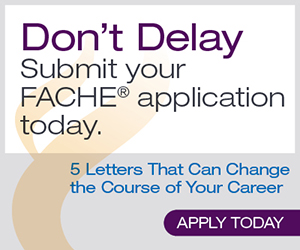Spend Trends: Optimizing spend for efficiency and resiliency
As an industry under constant budgetary pressure to stay within tight profit margins and up to date with rapidly advancing technology, healthcare organizations need control over employee spend and the ability to make smart, strategic spending decisions.

- Strategies to Secure and Retain Top Talent
- New York Chapter Reaches New Heights
- Secrets That Unlock Performance Excellence
- Still Time to Renew Your Annual Membership
Strategies to Secure and Retain Top Talent
Although the foundation of a solid workforce starts with recruitment, retaining great employees and minimizing burnout are vital to continued achievement. Leaders featured in the November/December issue of Healthcare Executive agree there isn’t a one-size-fits-all approach. “Ensuring there are many strategies to attract talent is imperative,” says Janelle Lee, RN, FABC, and an ACHE Member. She’s vice president of human resources at the University of Kansas Health System, which is using partnerships with local schools, including high schools, as one approach to recruitment.
Gadsden (Ala.) Regional Medical Center is involving potential new employees and key stakeholders in the hiring process, says Mark Dooley, FACHE, CEO. Setting realistic job requirements and having a potential new hire shadow the position for a few hours “can help both sides determine if this will most likely be a good match.”
In addition, employees are starting to place more value on benefits not directly tied to compensation. “If we want to ensure staff are happy and increase our retention efforts, we have to be cognizant of that shift,” says Dooley. “Research shows that the more personal control individuals can have over what they do, the more engaged and satisfied they are,” adds Carson Dye, FACHE.
For more strategies, read “Leadership Tips for Recruiting, Retaining and Empowering Employees” in the most recent issue of Healthcare Executive.
New York Chapter Reaches New Heights
Healthcare Leaders of New York hit a significant milestone this month when it reached 2,000 members, the first chapter to do so. This achievement corresponds with ACHE celebrating 20 years of chapters in 2024.
The chapter’s Membership Committee, led by Jeena Velzen, PhD, was instrumental in achieving that goal. New chapter members are recognized each month via LinkedIn to welcome them to the chapter and engage them early.
The chapter’s focus for the year was “Resilient Leadership Preparing for Tomorrow and Navigating the Future,” said Carle-Marie Memnon, DHA, FACHE, president, Healthcare Leaders of New York, which includes counties in New York City and surrounding areas. “Throughout the year, one of the goals included weaving in professional development and education programs concentrating on the future with a focus on patients, members and the communities we serve.”
Healthcare Leaders of New York is already working on its 2025 lineup of programs and initiatives. Under the leadership of Darren Deoraj, incoming president, the theme of the chapter’s plan will be “Back to Basics: Adding Value at Every Step.”
“We are looking to create programs aligned to our pillars of education, service, professional development, networking and advancement,” said Deoraj. “We are creating an education and professional development series aligned to each membership type and cohort, along with increasing our membership meetups across each region, planning targeted dinners, keynotes, panels, lunch and learns, town halls and a new member orientation program.”
With institutional support across the market, Healthcare Leadership of New York hopes to drive membership engagement to lead to higher levels of engagement, satisfaction, growth and retention.
ACHE chapters strive to add value for their members every day. To learn more about your chapter, log in to My ACHE and select My Chapter under Helpful Links.
Secrets That Unlock Performance Excellence
Swinging and colliding, the small metal balls in Newton’s cradle provide a visual demonstration of how leaders’ behaviors affect team members’ brains. “The most significant predictor of a team’s performance is the leader’s ability to manage their own cognitive and emotional responses,” says Michael E. Frisina, PhD, co-author of Leading With Your Upper Brain: How to Create the Behaviors That Unlock Performance Excellence.
Frisina and his brother Robert W. Frisina present a comprehensive methodology for effective leadership development, using insights from neuroscience. Michael Frisina says that leaders who operate from lower brain regions, which are dominated by fear and reactive impulses, undermine team morale. “When a leader is in a fearful state, they may shift into ‘survival mode,’ which not only diminishes their ability to lead effectively but also creates a toxic environment where team members feel insecure. This fear-driven behavior activates the amygdala, hijacking the brain’s capacity for higher-level functioning.”
The prefrontal cortex, or upper brain, however, is crucial for decision-making, problem-solving and emotional regulation. “Leaders who engage their upper brain foster trust, collaboration and innovation within their teams,” says Michael Frisina.
Leading With Your Upper Brain shows leaders how to cultivate self-awareness, practice emotional regulation, and lead with clarity, empathy and purpose.
Still Time to Renew Your Annual Membership
ACHE’s 2025 membership renewal process is ongoing. Current annual memberships expire Dec. 31. Renew your membership today and ensure continued access to exclusive member benefits while staying connected with your more than 49,000 healthcare leaders across the country and around the world.
For a quick and easy way to renew, log in through the My ACHE portal and click “My Membership” under the Helpful Links tab. You’ll find information about the installment payment option and the auto-renewal process for future years. For questions about your membership dues or renewal, contact ACHE’s Customer Service Center via email or by calling (312) 424-9400.



